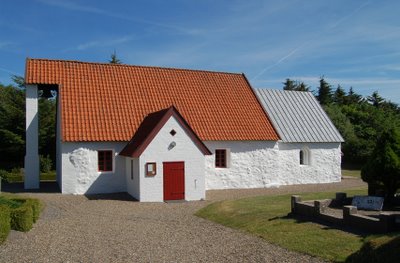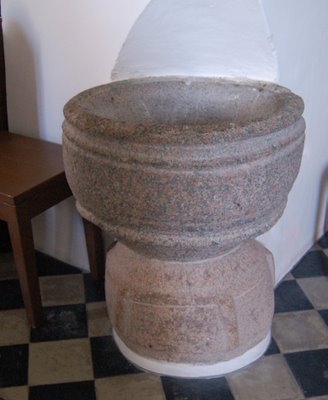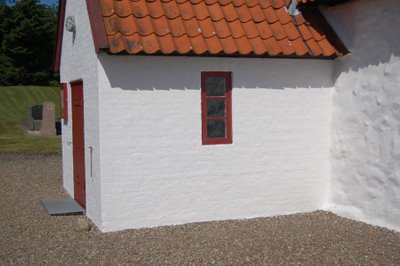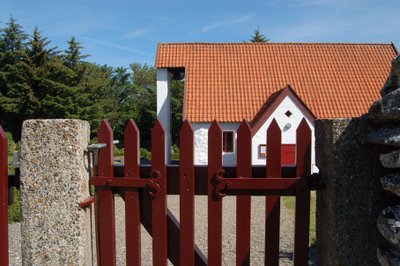
Vigsø Church

Interior


The baptismal font from 1100s.

Simplicity is tranquility

Vigsø Church, the entrance
The small lonely situated Vigsø Church has a choir and nave probably from the Romanesque period in the 1100s, a new porch to the south and a bell-gallow to the west. The original building is like Lild Church built in materials from the surrounding area - limestone, chalk and flint. The straight-edged south door is covered in planks and the north door is only seen as an inside point-arched niche. The inside of the church has beamed ceilings and the choir arch is newly bricked up with small stones like the porch and the bell-gallow. The church was restored in 1930.
The communion table had still in 1875 a monolitplate, but consists now of a plank-box from the same time as the altar piece, a simple, rather strange joinery, symbolizing Heaven's Door. A Romanesque granite font with a profiled basin has the foot partly walled in the choir arch. The pulpit is Renaissance from ab. 1600. The church bell from ab. 1500 is probably cast by Peder Hansen, Flensborg.
Some epitaphs from the 1700s and 1800s. Three grave-trees from the first of the 1800s are now in Thisted Museum and two others from the end of the 1700s are at the National Museum in Copenhagen.
Names in the Middle Ages and 1600s:
Vigsø (1442 Vixø, *1443 Vixe); Bjerre (* 1497 Bierby, 1552 Buierre); Rosholm (1662 Roesholm); Hesseldal ( 1600 Hiszildall, 1688 Hesseldall); Tovsgaard (1551 Tosberig, 1600 Todtzberig, Thoffdsberig, 1664 Thausgaard), Bavn (1663 Baun); Votborg (1664 Wotborig); Søborg (1418 Siøborich); Krægpøt (1666 Kregpyt); Ny and Gl. Overgård (1661 Offuergd).
In 1442-43 the væbner Jens Lauridsen is mentioned. (He had a squirrel in his coat of arms, and it is probably not true that he in several places was included under the family Friis of Vadskærgård, it is more possible that he belonged to the family Friis of Hesselager) Vixøgård is still mentioned in the end of the 1600s.
In the parish was the farm Brunbjerg (1603 Bronbiere, 1672 Brunbiere, 1688 Brundborig, 1778 Brundberg).
The area by Vigsø church shows that the subsurface is marked by chalk and flint. The church yard is piled up by lots and lots of flat flint blocks which probably were fetched from the beach. In 1555 the sand drift had damaged the parish terribly - and the parish priest suggested that Vigsø Church should be demolished. In 1690 there were dunes about 14 m high on the field by the vicarage. But the little simple church still lies there in a rather lonely place not far from the North Sea.
Listed prehistorics: 8 hills, of which one with a flat top on the church yard.
Demolished or destroyed: 18 hills, in one of them was a coffin built in limestone plates, it contained a bronze sword.
Source: Trap Danmark, Thisted amt, 1961.
photo June 2006: grethe bachmann
No comments:
Post a Comment